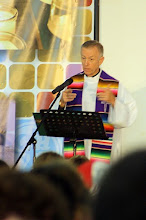
Holy Week is always a time of special seriousness and sadness liturgically, but this year is especially somber thanks to the accusations, revelations and admissions of sexual abuse of children by priests, pretty well throughout the world. Pope Benedict referred to it in his Palm Sunday homily, and New York Archbishop Timothy Dolan dealt with it directly, as did Dublin’s Archbishop Diarmuid Martin. I addressed the issue, as well, at our Palm Sunday liturgies.
It is time that the institutional Church as a whole, and I as an individual in that institution, admit we are sinners, that we have too often badly hurt people (sometimes accidentally, sometimes through stupidity or cruelty or insensitivity). Sometimes there was no wrong-doing as such, but only a perception by someone else of being wronged; even in cases like this, though, if someone is offended the offense is real for that person, and the reality is something I also have to deal with. Nothing other than confession will do. I have to face the fact that I am guilty in all these areas.
I think that for child abusers the simple act of apologizing and asking for forgiveness is too easy a way out. There needs to be, ideally, some authentic form of restitution (I am not thinking of anything financial here) and recognition that I have no right to expect forgiveness until and unless the persons offended freely choose to do so. And there needs to be some kind of punishment or penance. The false kind of mercy that was shown to Fr. Murphy is simply wrong: he begged not to be put on trial in ecclesiastical courts and to live out his priesthood with dignity. He didn’t have that right because he lost the dignity of his priesthood when he abused those deaf boys.
What is finally meant by “restitution” and “punishment” is hard to say, except that what constantly occurs to me is the process by which South Africa avoided a blood-bath when apartheid finally ended: it was the Truth and Reconciliation process by which victims and perpetrators sat down at tables facing one another, speaking to one another about what they did, or what they suffered. What if this could happen in the Catholic Church? Pope Benedict made a step in this direction when he met with victims of sexual abuse during his pastoral visit to the United States in 2008. What if the “Fr. Murphys” of the Catholic world had to do the same with their actual victims?
The crucifixion that we commemorate this week should have us all on our knees, crying. And I pray the grace of Easter will make me less sinful and a better priest and more faithful to the One who is utterly faithful to me—to us. The Church as institution may crumble—so what? The Church as Body of Christ will not be overcome.
It is time that the institutional Church as a whole, and I as an individual in that institution, admit we are sinners, that we have too often badly hurt people (sometimes accidentally, sometimes through stupidity or cruelty or insensitivity). Sometimes there was no wrong-doing as such, but only a perception by someone else of being wronged; even in cases like this, though, if someone is offended the offense is real for that person, and the reality is something I also have to deal with. Nothing other than confession will do. I have to face the fact that I am guilty in all these areas.
I think that for child abusers the simple act of apologizing and asking for forgiveness is too easy a way out. There needs to be, ideally, some authentic form of restitution (I am not thinking of anything financial here) and recognition that I have no right to expect forgiveness until and unless the persons offended freely choose to do so. And there needs to be some kind of punishment or penance. The false kind of mercy that was shown to Fr. Murphy is simply wrong: he begged not to be put on trial in ecclesiastical courts and to live out his priesthood with dignity. He didn’t have that right because he lost the dignity of his priesthood when he abused those deaf boys.
What is finally meant by “restitution” and “punishment” is hard to say, except that what constantly occurs to me is the process by which South Africa avoided a blood-bath when apartheid finally ended: it was the Truth and Reconciliation process by which victims and perpetrators sat down at tables facing one another, speaking to one another about what they did, or what they suffered. What if this could happen in the Catholic Church? Pope Benedict made a step in this direction when he met with victims of sexual abuse during his pastoral visit to the United States in 2008. What if the “Fr. Murphys” of the Catholic world had to do the same with their actual victims?
The crucifixion that we commemorate this week should have us all on our knees, crying. And I pray the grace of Easter will make me less sinful and a better priest and more faithful to the One who is utterly faithful to me—to us. The Church as institution may crumble—so what? The Church as Body of Christ will not be overcome.
PS--The illustration is of the Crucifixion by Giotto, in the lower basilica of San Francesco in Assisi. Look at the grief of the angels; shouldn't we have that kind of grief at the torture of the Body of Christ?
Below is a bonus for our Holy Week meditation from JS Bach's "St. Matthew Passion."









